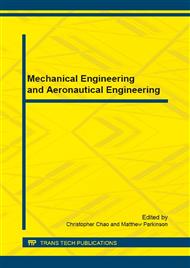p.83
p.90
p.95
p.103
p.110
p.118
p.123
p.128
p.133
Influence of Control Coupling Effect on Landing Performance of Flying Wing Aircraft
Abstract:
As flying wing aircraft has no tail and adopts blended-wing-body design, most of flying wing aircrafts are directional unstable. Pitching moment couples seriously with rolling and yawing moment when control surfaces are deflected, bringing insecurity to landing stage. Numerical simulation method and semi-empirical equation estimate method were combined to obtain a high aspect ratio flying wing aircraft’s aerodynamic coefficients. Modeling and simulation of landing stage were established by MATLAB/Simulink. The control coupling effect on lift and drag characteristics and anti-crosswind landing capability was studied. The calculation results show that when the high aspect ratio flying wing aircraft was falling into the deceleration phase, appropriate to increase the opening angle of split drag rudder can reduce the trimming pitching moment deflection of pitch flap, thereby reduce the loss of lift caused by the deflection of pitch flaps. Flying wing aircraft can be rounded out successfully by using the pitch flap gently and steady. Both side-slip method and crabbed method can be applied to the landing of high aspect ratio flying wing aircraft in crosswind, the flying wing aircraft’s anti-crosswind landing capability was weakened by the control coupling effect of split drag rudder and elevon. Sideslip method was recommended in the crosswind landing of flying wing aircraft after calculation and analysis.
Info:
Periodical:
Pages:
110-117
Citation:
Online since:
March 2016
Authors:
Price:
Сopyright:
© 2016 Trans Tech Publications Ltd. All Rights Reserved
Share:
Citation:


